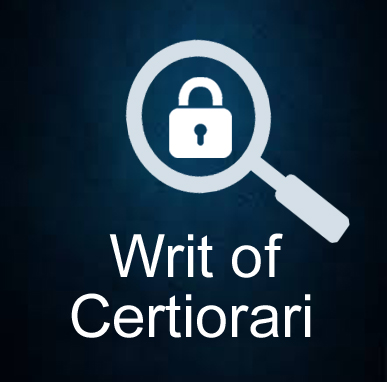Certiorari (certioro, certiorare) என்பது இலத்தின் வார்த்தையாகும் இதன் பொருள் கூறுதல் அல்லது தெரிவித்தல் அல்லது ஆவணங்களை காட்டுதல் என்பதாகும். ஆங்கிலத்தில் இதனை to inform, apprise, show or to be certified என்றும் கூறுவார்கள்.
இந்த ஆணையின் கீழ் நீதிமன்றங்கள் தனக்கு கீழ் உள்ள நீதி மன்றத்துக்கோ அல்லது குவாசி நீதிமன்றத்துக்கோ அல்லது தீர்பாயத்துக்கோ அல்லது சட்ட ரீதியான ஒரு அமைப்பு சட்டப்பிரச்சனை களை களைவதற்கு அமைக்கப்பட்டுள்ளது அதனை இந்த உத்தரவு கட்டுப்படுத்தலாம். எவ்வாறு எனி்ல் அந்த சட்ட தீர்பபுகளில் தவறான ஒரு முன் உதாரணத்தை உட்படுத்துவது அல்லது ஒரு தவறான ஆவணத்தின் அடிப்படையில் தீர்ப்பளிக்கும் போதும் அல்லது குடிமக்களின் அடிப்படை உரிமையை பறிக்கும் போதும்.
இந்த நெறிமுறை உறுத்தும் நீதிப் பேராணை பயன் படுத்தலாம்
உதாரணம் - ஒரு கோட்டாச்சியருக்கு ஒருவர் தன் தாயை கவனிக்கவில்லை தன் சகோதரர் என்று ஒரு சகோதரி கோரிக்கை விடுக்கின்றார். அதனால் அவரின் சொத்தை தன் தாயின் பெயரிலோ அல்லது தன் பெயரிலோ மாற்ற வேண்டும் என்று கோருகிறார். அந்த கோட்டாச்சியரும் அதனை தீர விசாரிக்காமல் ஒரு தீர்ப்பை வழங்குகிறார் அல்லது அத்தகைய மகனின் சொத்தை கைப்பற்ற ஒரு ஆணையிடுகிறார். இது ஒரு தவறான முன் உதாரணமாகும். அந்த அலுவலர் தன்னிடம் அளிக்கப்பட்ட புகாரின் தன்மையை அறிந்தப்பின் அதனை தீர புலன்விசாரனை செய்ய வேண்டும். செய்யாமல் இத்தகைய நடவடிக்கைகள் தவறான முன் உதாரணங்களாகும். இந்த சமயங்களில் இந்த நெறிமுறை உறுத்தும் நீதிப் பேராணை பயன் படுத்தலாம். (இதனை suo moto என்ற அதிகாரத்தை தவறாக பயன் படுத்துவதாகும்)
மேலும் ஒரு வழக்கு தமிழகத்தில்
அன்பழகன் எதிர் கோட்டாச்சியர் கிருஷ்ணகிரி
வழக்கின் சுருக்கம் பெற்றோரை கவனிக்காத பிள்ளையின் சொத்தை - அதாவது அந்த சொத்து அவரின் பெற்றோரிடமிருந்து பெற்று இருக்கம் பட்சத்தில் அதனை அவருக்கே கொடுக்க வேண்டும் என
கோட்டாச்சியர் கிருஷ்ணகிரி ஆணையிடுகிறார். அது அவ்வாறே நீதி மன்றத்தில் தீர்ப்பாகிறது.
இதைப் பயன்படுத்துவது எப்போதெனில்
1. ஒரு சட்ட அமைப்பு (Quasi-Judicial) தவறான சட்டத்தை பயன் படுத்தும் போதும்.
2. ஒரு நீதிமன்றம் அல்லது அமைப்பு சட்ட முறையின்றி செயல்படும் போதும்.
3. ஒரு பிழையுடன் கூடிய ஒரு ஆவணத்தை சாட்சியமாக பயன்படுத்தி தீர்ப்பளிக்கும் போதும்.
4. ஒரு நீதி மன்றம் அல்லது சட்ட அமைப்பு (Quasi-Judicial) ஒரு தீர்ப்பை அடிப்படை உரிமைக்கு எதிராக வழங்கும் போதும்.
5. ஒரு நீதி மன்றம் அல்லது சட்ட அமைப்பு (Quasi-Judicial) ஒரு தீர்ப்பை நீதிக்கு எதிராக வழங்கும் போதும்.
6. இந்த ஆணையை ஒரு தனி மனிதருக்கும் (private person) அல்லது தனியார் நிறுவனத்தும் (private form or private company) ஆணையிட முடியாது
7. இந்த ஆணையை ஒரு சட்ட மன்றத்துக்கும் (legislature) அல்லது செயல்படுத்தும்(executive) ஒரு ஆனையத்துக்கு இட முடியாது.
சட்ட தீர்ப்புக்கள்
1. குல்லாபள்ளி நாகேஷ்வர ராவ் எதிர் A.P.S.R.T.C (AIR 1959 SC 1376 AP)
2. Mineral Developmemt ltd vs State Of Bihar (AIR 1969 SC 468)
Writ of Certiorari
It is a writ (order) of a higher court
to a lower court to send all the documents in a case to it so the higher
court can review the lower court’s decision. Appellate review of a
case that is granted by the issuance of certiorari is sometimes called
an appeal, although such review is at the discretion of the appellate
court. A party, the petitioner, files a petition for certiorari with the
appellate court after a judgment has been rendered against him in the
inferior court.
However, unlike a writ of prohibition,
superior courts issue writs of certiorari to review decisions which
inferior courts have already made. The writ of prohibition is the
counterpart of the writ to certiorari which too is issued against the
action of an inferior court.
The difference between the two was
explained by Justice
Venkatarama Ayyar of the Supreme Court in the
following terms:
“When an inferior court takes up for
hearing a matter over which it has no jurisdiction, the person against
whom the proceedings are taken can move the superior court for a writ of
prohibition and on that an order will issue forbidding the inferior
court from continuing the proceedings. On the other hand, if the court hears
the cause or matter and gives a decision, the party aggrieved would have
to move the superior court for a writ of certiorari and on that an
order will be made quashing the decision on the ground of want of
jurisdiction.”
When Can the Writ of Certiorari be issued !?
1. Where the quasi-judicial authority acted under an invalid law.
2. Where the court or authority acted with out jurisdiction.
3. Where there is an error of law apparent on the face of the record.
4. Where the inferior court or quasi court-authority acted agaist the principles of natural justice;
5. Where the inferior court or quasi court-authority against fundamental rules;
6. This Writ cannot be issued agaist private person or private company
7. It cannot be issued against legislature or executive.
6. This Writ cannot be issued agaist private person or private company
7. It cannot be issued against legislature or executive.
Thanks
http://www.simplydecoded.com/2013/01/30/different-writs-and-their-importance/ & Special Thanks to - Sujatha Law Series - Administrative Laws - Author by Gade Veera Reddy
குறிப்பு - இந்த பகுதியில் உள்ளவற்றை பொது அறிவாக மட்டும் எடுத்துக் கொள்ள வேண்டும் ஏதாவது சட்ட நுனுக்கம் தவறாக இருப்பின் சுட்டிக் காட்டுங்கள் திருத்திக்கொள்கிறோம். இதையே இறுதி வடிவமாக எடுத்துக் கொள்ளக்கூடாது. மேலும் இது வழக்குக்குரியதல்ல.





தெளிவான விளக்க நடை அருமை நண்பா....
ReplyDeleteவருகைக்கு நன்றி பலருக்கு செனறடைய என்ன செய்ய வேண்டும். ஒட்டுப்பட்டை வேலை செய்யவில்லை அன்பரே
ReplyDelete